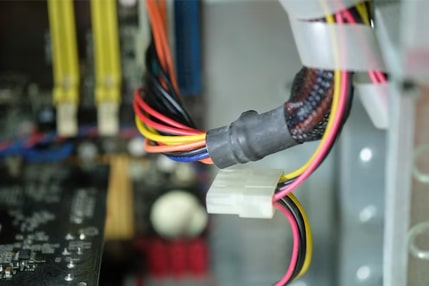The measurement of insulation thickness
The measurement of insulation thickness is conducted in accordance with the requirements of the standard BS EN 60811-201. This standard covers the method for measurement of insulation thickness for testing non-metallic materials of all cable types referenced in standards for cable construction and cable materials.
The measurements may be taken using a measuring microscope or profile projector offering at least 10x magnification or an optical digital image analyser. The two types of equipment must be capable of providing a reading accuracy of 0.01mm and an estimated reading to three decimal places when measuring
insulation thickness with a specified thickness less than 0.5mm.
The test sample is prepared by removing any covering over the insulation and the conductors the insulation protects. A thin slice is then taken, perpendicular to the
longitudinal axis of the conductor (a circular slice) and placed flat under the measuring equipment so that the plane of the slice perpendicular to that of the
measuring device lens.
Six measurements are then taken, each approximately 60° from the last. The first of these measurements is at the thinnest point of the insulation wall. The results
are evaluated as specified in the relevant cable standard, generally against a required mean value and minimum value.
Insulation thickness is an essential test and determines that there is sufficient insulation material applied whilst also serving as a measure of how concentric
that insulation material is. Adequate insulation of the conductor is required to provide sufficient electrical integrity to maintain safety and mechanical
strength to protect against stresses on the material.
Bài viết liên quan
Let’s start with some individual definitions: Wire: A wire is a single conductor made up of an electrically conductive material like aluminum or copper. This conductor can be made up of one strand of material or a group of strands and may be left bare or surrounded by a color-coded sheath. Regardless of the number of […]
Selecting the right cable involves a systematic decision-making process to ensure the specific requirements of the intended application are met. Clearly define the project or product’s cabling requirements such as: voltages, currents, signal type, environmental conditions, signal integrity, signal frequencies, RFI susceptibility and emissions, and any relevant regulations or standards. Based on the close […]
Tiêu đề: Measurement of Sheath Thickness The measurement of sheath thickness in cables is conducted in accordance with the requirements of the standard BS EN 60811-202. This standard covers the method for measurement of sheath thickness for testing non-metallic materials of all cable types referenced in standards for cable construction and for cable materials. The […]





